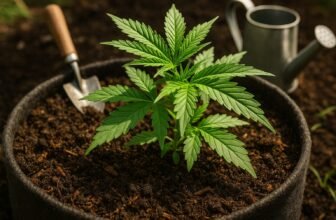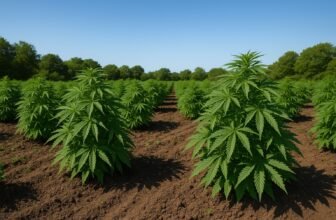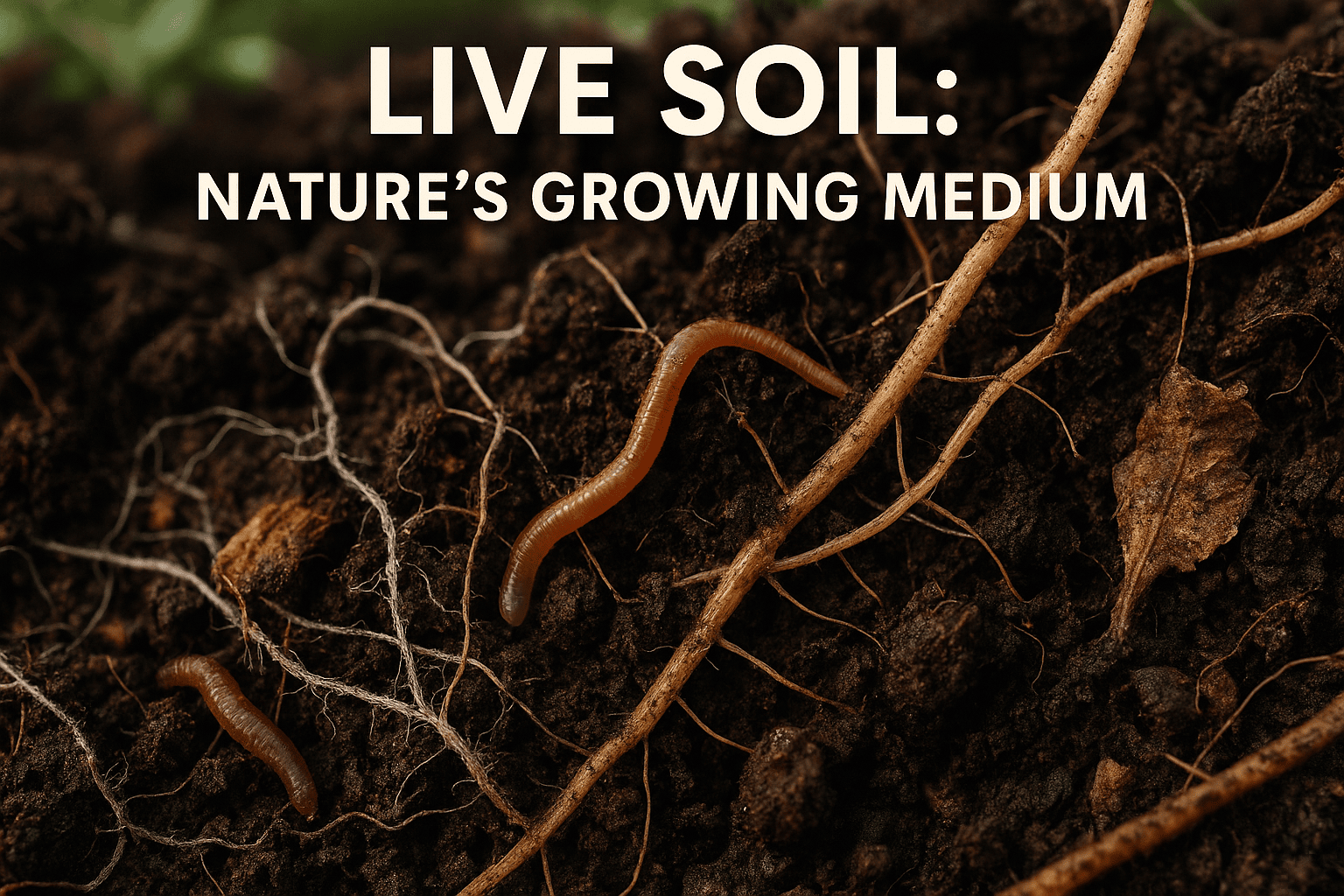
Live soil—often referred to as living soil—is more than just dirt; it’s a thriving, self-sustaining ecosystem full of beneficial microbes, fungi, and other soil organisms that work in harmony to support healthy plant growth. Unlike conventional potting mixes or sterile soils, live soil teems with biological activity that mimics the natural processes found in undisturbed forest floors and wild environments.
At its core, live soil operates through a dynamic system known as the soil food web, where bacteria, fungi, nematodes, earthworms, and arthropods interact to break down organic matter, cycle nutrients, and promote soil structure. These microscopic allies transform complex nutrients into plant-available forms, reducing the need for synthetic fertilizers and chemical inputs. This makes living soil ideal for organic gardening, sustainable farming, and even high-performance cannabis cultivation.
Whether you’re growing vegetables, flowers, or medicinal herbs, using live soil allows your plants to tap into a natural network of support—resulting in healthier root systems, stronger resistance to pests and diseases, and richer yields. Gardeners embracing this regenerative agriculture approach often report better flavor, aroma, and terpene profiles in their produce.
In a time when many growers are shifting away from hydroponics and chemically fed mediums, live soil offers a low-maintenance, environmentally friendly solution that replenishes itself over time. If you’re looking to enhance soil biodiversity, reduce nutrient lockout, and grow plants as nature intended, then transitioning to a living soil system could be the smartest move for your garden.
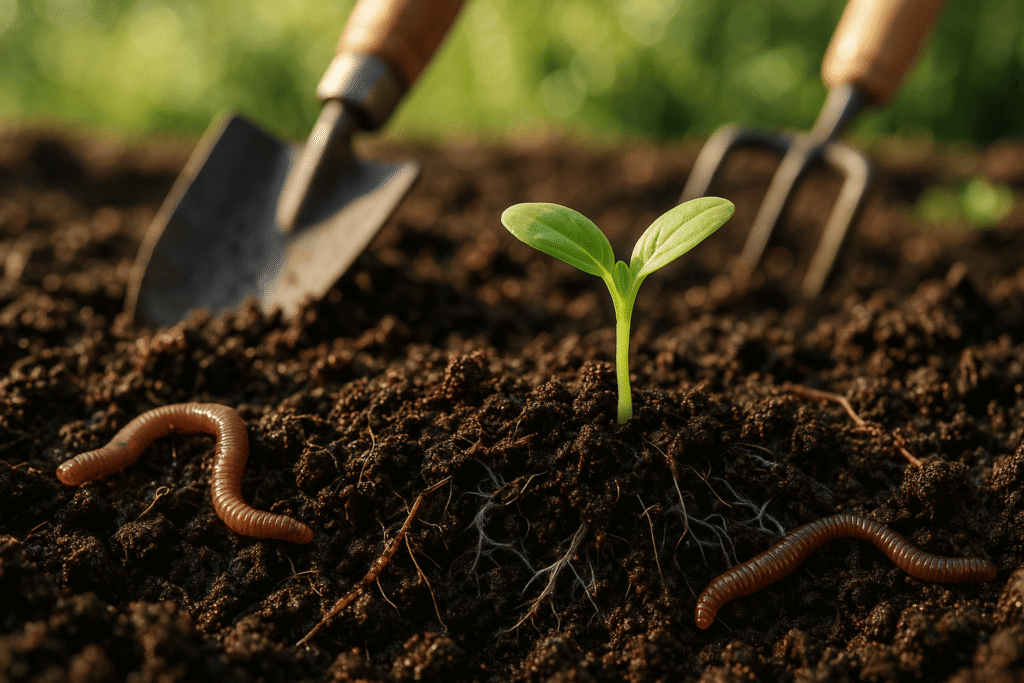
Why Live Soil Matters in Today’s Growing Practices
In the age of regenerative gardening and eco-conscious farming, live soil has become more than just a buzzword—it’s a foundational pillar of sustainable growing. Traditional soil and hydroponic methods often rely heavily on synthetic fertilizers, sterile mediums, and chemical inputs that can degrade soil health over time. In contrast, living soil systems provide a holistic, nature-inspired approach that nourishes both your plants and the earth beneath them.
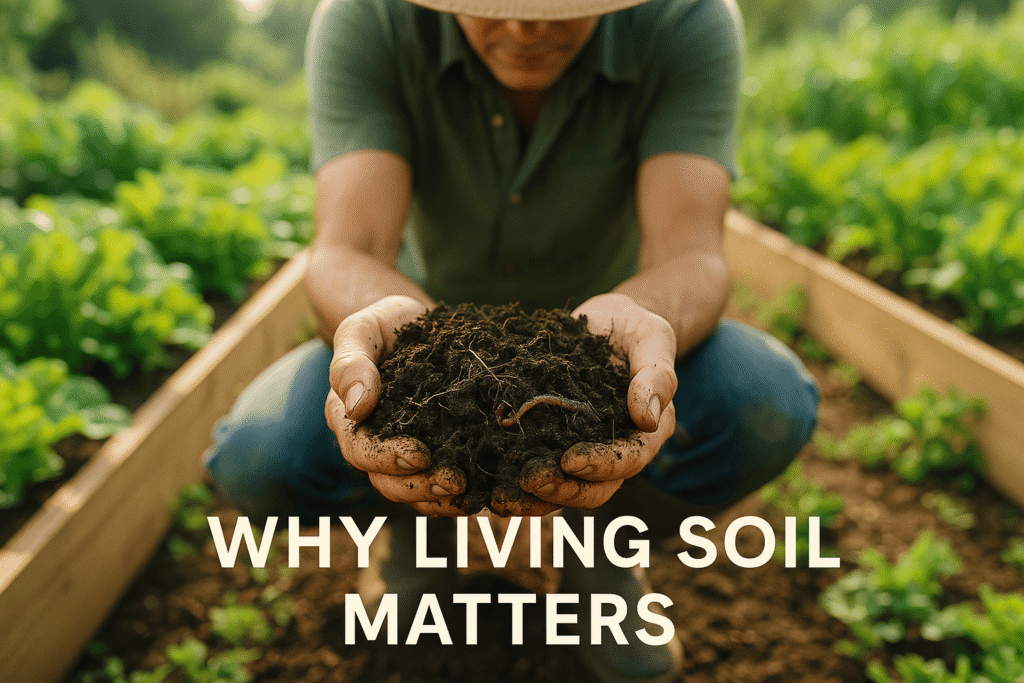
Let’s break down why live soil is gaining such traction among home gardeners, organic farmers, and even cannabis cultivators:
Supports the Soil Food Web
Live soil is alive with beneficial microorganisms—bacteria, fungi, protozoa, arthropods, and earthworms—all working together to decompose organic matter, cycle nutrients, and maintain soil structure. This soil food web creates a balanced ecosystem that boosts plant health from the roots up.
Reduces the Need for Chemical Inputs
Because live soil is rich in microbial life and organic nutrients, there’s often no need for synthetic NPK fertilizers. The microbes naturally break down organic matter into forms that plants can easily absorb, ensuring steady growth without the risk of nutrient burn or pH imbalance.
Improves Soil Structure and Water Retention
The biological activity within living soil promotes aeration, root penetration, and moisture retention—all critical for vigorous root development. The presence of organic matter and fungal hyphae helps bind soil particles into stable aggregates, creating ideal conditions for root oxygenation.
Boosts Plant Immunity and Terpene Production
Plants grown in living soil are often more resilient to pests and diseases due to symbiotic relationships with mycorrhizal fungi and beneficial bacteria. In cannabis, this translates to stronger terpene expression and enhanced aroma profiles.
Aligns with Sustainable and Organic Gardening Practices
Using live soil aligns with organic certification standards and encourages long-term soil health. It reduces runoff pollution, supports carbon sequestration, and helps build biodiverse microbial communities that keep ecosystems thriving.
What Is Live Soil? Understanding Its Composition and Microbial Life
At its essence, live soil—also called living soil—is a biologically active growing medium packed with beneficial organisms and rich organic matter. Unlike sterile potting mixes that contain inert ingredients, live soil mimics the natural environments found in healthy forest floors and wild ecosystems.
This type of soil is teeming with microbial life, including bacteria, fungi, nematodes, protozoa, and more. Together, they form the soil food web, a complex and self-sustaining system that supports nutrient cycling, root health, and long-term soil fertility.
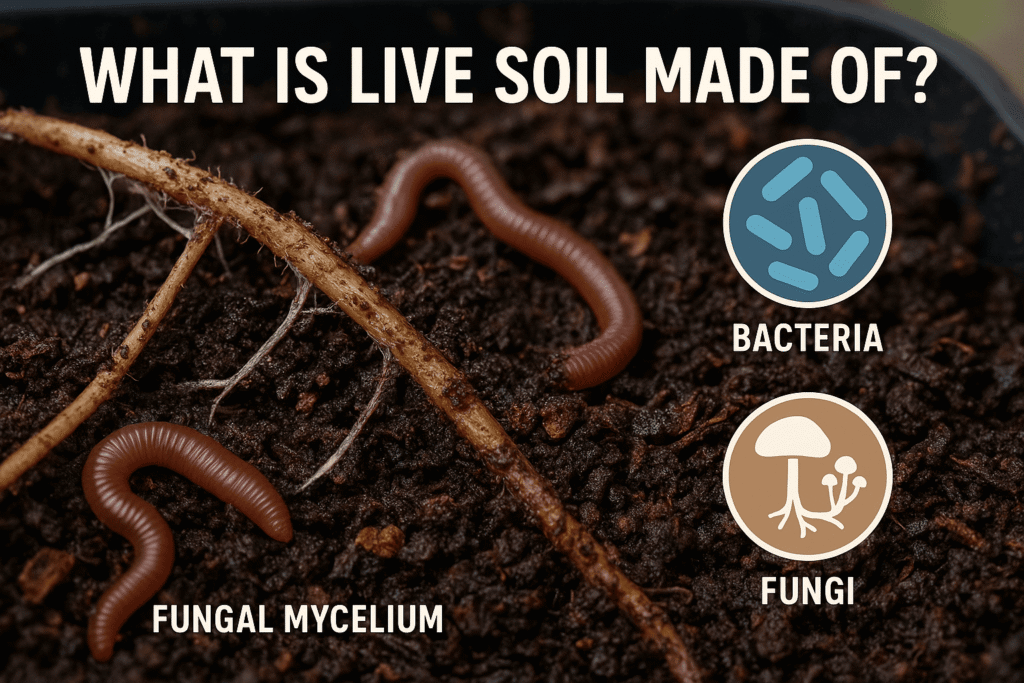
Here’s a breakdown of what makes live soil so powerful:
Beneficial Microbes (Bacteria & Fungi)
Bacteria decompose organic matter, releasing essential nutrients like nitrogen, phosphorus, and potassium. Mycorrhizal fungi attach to plant roots, increasing nutrient and water absorption while protecting against pathogens. These microbes work symbiotically with plant roots, forming biofilms and communicating through root exudates.
Organic Matter & Compost
Live soil includes fully decomposed compost, worm castings, and humus, which provide slow-release nutrients and feed the microbes. Organic matter improves soil structure and enhances moisture retention and aeration.
Soil Invertebrates (Worms, Arthropods, Nematodes)
Earthworms help break down organic matter and aerate the soil. Arthropods and nematodes consume microbes and each other, releasing nutrients in plant-available forms. These creatures also help control harmful pathogens by maintaining ecological balance.
Aeration and Drainage Elements
Ingredients like pumice, perlite, or lava rock ensure proper airflow and drainage while maintaining root-zone oxygenation. These elements prevent compaction and allow microbes and roots to thrive.
Mineral Content and Rock Dust
Natural amendments like azomite, basalt rock dust, and glacial rock powder supply essential trace minerals. These minerals feed the soil microbiome and support enzymatic activity in plants.
🌿 The Big Picture: A Living Ecosystem
Live soil isn’t just a passive medium—it’s a thriving, self-regulating ecosystem. When built and maintained correctly, it becomes a closed-loop system where every organism plays a role in maintaining plant health. This approach not only improves plant vitality and yield but also reduces the need for chemical interventions.
How Does Live Soil Work? The Science Behind the Soil Food Web
Live soil functions as a self-sustaining biological ecosystem, where each organism plays a critical role in nutrient cycling, soil health, and plant vitality. At the core of this dynamic system is the soil food web—a natural network of microbes, fungi, and soil fauna that work together to make nutrients bioavailable to plants.
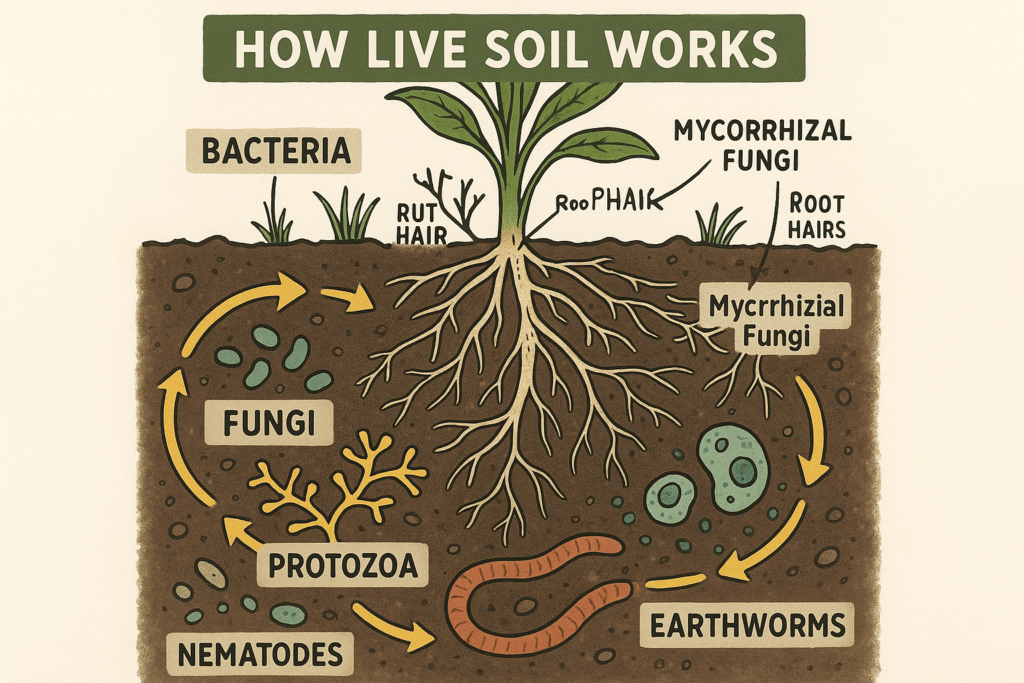
Rather than relying on synthetic inputs, living soil systems use biology to break down organic matter and feed the plant naturally. Let’s explore how this underground community operates and why it’s essential for regenerative gardening, organic farming, and cannabis cultivation.
The Soil Food Web in Action
The soil food web is a chain of biological interactions, where organisms like bacteria, fungi, protozoa, nematodes, and arthropods break down organic matter in stages. As microbes consume decaying plant material or compost, they release essential nutrients like nitrogen, phosphorus, and potassium into the root zone. These nutrients are transformed into ionic forms that are easily absorbed by plant roots.
Mycorrhizal Fungi & Root Symbiosis
Mycorrhizal fungi attach to plant roots and form a mutualistic relationship—expanding the root system and improving water and nutrient uptake. These fungi create a mycelial network that acts like a communication and transport system underground. They help mobilize hard-to-reach nutrients such as phosphorus, calcium, and zinc.
Beneficial Bacteria & Decomposition
Soil-dwelling bacteria break down organic matter, turning compost, plant residues, and animal waste into plant-available forms. These microbes also produce enzymes, hormones, and antibiotics that suppress harmful pathogens. Some bacteria (like rhizobia) fix atmospheric nitrogen into usable forms for legumes and other plants.
Predators & Nutrient Release
Protozoa and nematodes feed on bacteria and fungi, releasing excess nutrients in a process called microbial grazing. This nutrient release occurs right in the rhizosphere—the area immediately surrounding plant roots—allowing for rapid absorption.
Earthworms and Soil Aeration
Earthworms digest organic material, creating worm castings that are nutrient-rich and microbially active. Their burrowing naturally aerates the soil, improving oxygen flow and root penetration.
🧠 The Result: A Closed-Loop Growing System
When these processes work together, live soil becomes a closed-loop nutrient system. Plants don’t rely on synthetic feeds because the biology in the soil continually processes and releases nutrients in harmony with the plant’s needs. This minimizes nutrient lockout, improves soil structure, and enhances plant immunity and flavor profile in crops like cannabis, herbs, and vegetables.
Benefits of Using Live Soil for Cannabis and Vegetable Gardens
Using live soil offers significant advantages for both cannabis cultivation and vegetable gardening, especially for those prioritizing organic practices, flavor enhancement, and long-term soil health. Since live soil contains beneficial microbes, fungi, and decomposers that form a living ecosystem, it naturally supports plant growth without the need for chemical fertilizers.

This biologically rich soil improves not only plant health but also enhances yields, terpene profiles, and resilience—making it a favorite among both organic growers and sustainable farmers.
Maximizes Nutrient Uptake Without Synthetic Fertilizers
Microbes and fungi in living soil break down organic matter and convert it into plant-available nutrients, reducing dependency on bottled nutrients. Nutrients are slowly released and synchronized with the plant’s growth stages. Ideal for organic certifications and chemical-free gardening.
Enhances Terpene and Flavor Profiles in Cannabis and Produce
Healthy microbial activity supports robust root systems, which improves the uptake of secondary metabolites. In cannabis, this translates to more potent aromas and terpene expressions. In vegetables and herbs, it improves flavor complexity, aroma, and nutrient density.
Strengthens Plant Immunity and Pest Resistance
Beneficial microbes produce natural antibiotics and suppress harmful pathogens in the rhizosphere. Mycorrhizal fungi enhance root defenses by forming protective biofilms and blocking disease penetration. Plants grown in living soil are often more resilient to environmental stress.
Improves Soil Structure, Drainage, and Moisture Retention
The biological activity of earthworms and fungi aerates the soil, preventing compaction and improving oxygenation. Organic matter improves water retention, reducing the frequency of irrigation. Better drainage leads to healthier root zones and prevents root rot.
Supports Long-Term Soil Health and Sustainability
Live soil acts as a regenerative system, building richer soil over time with each grow cycle. You can reuse and amend it with compost teas or top-dressings instead of starting fresh every season. Encourages biodiversity, carbon sequestration, and sustainable land use.
🌱 Real-World Impact:
Growers using live soil consistently report higher-quality yields, better taste, and fewer issues with pests and nutrient deficiencies. Whether you’re cultivating tomatoes, peppers, or high-terpene cannabis strains, the benefits of this living ecosystem become evident season after season.
Live Soil vs. Sterile Soil: Key Differences You Should Know
When choosing a growing medium, understanding the contrast between live soil and sterile soil is essential—especially for those interested in organic gardening, regenerative practices, or high-quality cannabis cultivation. While both mediums can grow plants, their composition, biological activity, and long-term effects on plant health are drastically different.
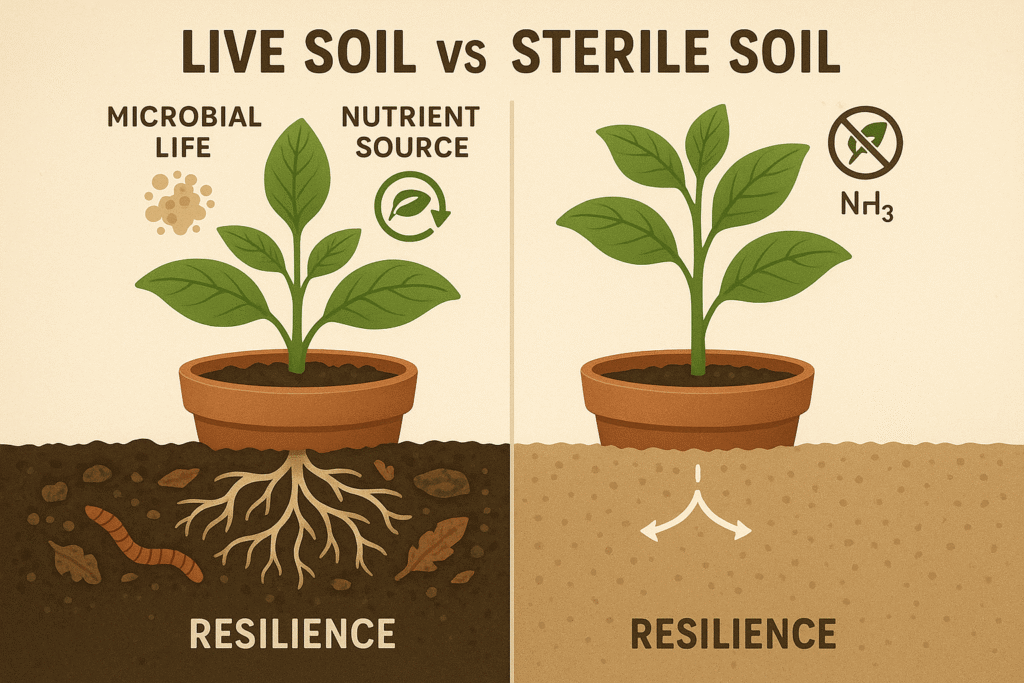
Let’s compare these two systems to help you decide which one aligns with your growing goals.
Biological Activity
- Live Soil: Rich in beneficial microbes, fungi, and insects; forms a self-sustaining soil food web that continually breaks down organic matter.
- Sterile Soil: Completely devoid of microbial life; typically baked, pasteurized, or chemically treated to eliminate pathogens.
Nutrient Delivery System
- Live Soil: Nutrients are released through natural decomposition and microbial mineralization. Fertilization often comes from compost, worm castings, and organic amendments.
- Sterile Soil: Relies heavily on synthetic fertilizers or bottled nutrients, which can lead to nutrient lockout or salt buildup over time.
Plant Health & Resilience
- Live Soil: Encourages stronger root systems, better pest resistance, and overall plant immunity due to beneficial microbial interactions.
- Sterile Soil: Plants are more vulnerable to disease and pests because there are no microbes to support the plant’s natural defenses.
Environmental Impact
- Live Soil: Promotes sustainability, carbon sequestration, and can be reused and revitalized with compost teas or cover crops.
- Sterile Soil: Often used in hydroponics or container gardening with limited reuse potential; contributes to more waste.
Maintenance and Learning Curve
- Live Soil: Lower maintenance once established, but requires understanding of biological balance and microbial care.
- Sterile Soil: Easier for beginners using feed charts, but dependent on frequent nutrient applications and pH monitoring.
📊 Comparison Table Summary
| Feature | Live Soil | Sterile Soil |
|---|---|---|
| Microbial Life | Rich and diverse | None |
| Nutrient Delivery | Microbial nutrient cycling | Synthetic fertilizers |
| Pest & Disease Resistance | High (microbial support) | Low |
| Reusability | Yes (with amendments) | Rarely reusable |
| Ideal For | Organic & regenerative growing | Hydroponics or short-term grows |
🧠 Key Takeaway:
If you’re looking for a more natural, sustainable, and self-sufficient way to grow—especially for cannabis, herbs, or heirloom vegetables—living soil is the superior choice. However, sterile soils still have a place in controlled environments where precision feeding and rapid growth are priorities.
How to Make Your Own Live Soil at Home – DIY Live Soil
Creating your own live soil is one of the most rewarding steps you can take as a gardener or cannabis grower. Homemade living soil allows you to control every ingredient while building a biologically rich and self-sustaining soil food web tailored to your specific plants. The process is surprisingly simple and uses affordable, natural materials that work together to feed both your soil and your crops.
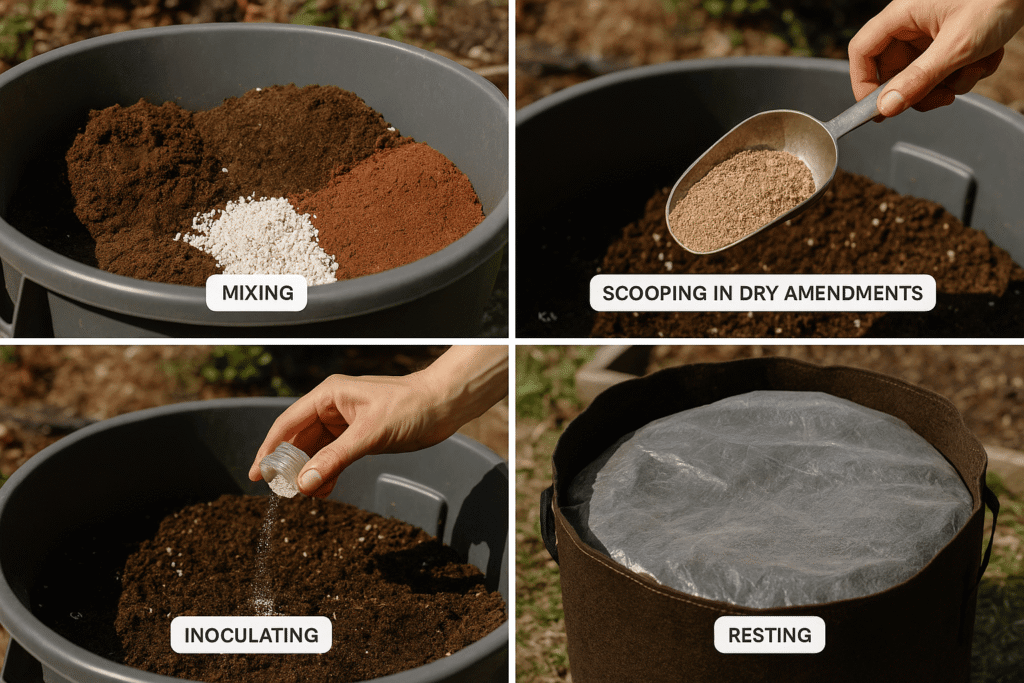
Here’s how to build a high-quality DIY living soil mix using organic ingredients, microbial inoculants, and natural minerals.
Start with a Rich Base (Compost, Worm Castings, Peat/Coco)
Use quality compost and worm castings as the microbial foundation. These provide organic matter, beneficial microbes, and nutrients. Blend with peat moss or coco coir for moisture retention and a stable structure.
Add Aeration and Drainage Materials
Incorporate perlite, pumice, or lava rock to enhance airflow and prevent compaction. Good soil aeration helps microbial activity and ensures roots get enough oxygen.
Mix in Organic Amendments for Long-Term Nutrition
Use dry amendments like kelp meal, alfalfa meal, crustacean meal, and neem cake for slow-release macro and micronutrients. These feed both the plants and the microbial life over several weeks or months.
Inoculate with Beneficial Microbes & Fungi
Add mycorrhizal fungi, EM-1 (Effective Microorganisms), or compost tea to jump-start microbial colonization. These inoculants strengthen root symbiosis and speed up decomposition of organic materials.
Let the Soil Cook (Curing Period)
After mixing, moisten the soil lightly and let it “cook” or cure in a breathable container for 2–4 weeks. During this time, microbial populations multiply, and nutrients begin to stabilize.
🌿 Optional Additions for Extra Biology
- Add biochar to improve microbial habitat and carbon retention.
- Use cover crops or mulch to maintain soil health between growing seasons.
🧪 DIY Live Soil Recipe Example (1 Cubic Foot):
- 1 part compost
- 1 part peat moss or coco coir
- 1 part perlite or pumice
- ½ cup kelp meal
- ½ cup alfalfa meal
- ½ cup neem cake
- 1 tbsp mycorrhizal fungi or EM-1 solution
- Water to field capacity and store in a cool, dark place to cure
5 Best Ready-Made Live Soil Brands (Top Picks for 2025)
If you want the benefits of living soil without the work of mixing your own, there are several high-quality pre-made live soil brands available that deliver exceptional performance—especially for cannabis growers, vegetable gardeners, and organic enthusiasts. These soils come pre-inoculated with beneficial microbes, contain balanced organic amendments, and are ready to use right out of the bag.

Here’s a curated list of the top-rated living soil mixes for 2025 based on quality, consistency, microbial diversity, and plant performance.
1. BuildASoil – Craft Blend Living Soil
- Small-batch, artisanal soil made with premium organic amendments like aloe, malted barley, kelp meal, and neem cake.
- Rich in microbial life, great for no-till gardening and organic cannabis.
- Supports multiple grow cycles with proper re-amendments.
2. Sohum Living Soil
- Complete, ready-to-use super soil formulated for cannabis and food crops
- Designed for water-only growing, eliminating the need for bottled nutrients
- Contains mycorrhizae, composted forest humus, bone meal, and fish hydrolysate
3. Purple Cow Indicanja Organic Soil
- OMRI-listed, microbial-charged soil designed specifically for medical cannabis growers
- Contains compost, peat, fishbone meal, kelp, and microbial inoculants
- Well-balanced for veg and flower stages with consistent performance
4. Nature’s Living Soil Autoflower Concentrate
- Specialized for autoflower cannabis strains, with extra mycorrhizae and nutrient buffers
- Used as a bottom layer “hot zone” or as a full mix for autoflower setups
- Great for beginners who want to avoid nutrient burn
5. Michigan Made Mix (M3) Super Soil
- Michigan-based company offering a robust living super soil for growers who want simplicity
- Includes castings, compost, bat guano, rock dust, and biochar
- Designed for “just add water” performance across multiple crops
| Brand | Key Ingredients | Best For | Unique Feature |
|---|---|---|---|
| BuildASoil Craft Blend | Aloe, barley, neem, compost | No-till, cannabis | Artisan small-batch quality |
| Sohum Living Soil | Forest humus, bone meal, fish hydrolysate | Water-only grows | No nutrients needed |
| Purple Cow Indicanja | Kelp, fishbone, peat, compost | Medical cannabis | OMRI-listed & organic |
| Nature’s Living Soil | Mycorrhizae, worm castings, bat guano | Autoflowers | Nutrient-layer strategy |
| Michigan Made Mix | Biochar, compost, bat guano | Vegetables & cannabis | Local U.S. mix with biochar |
Top 10 Living Soil Mixes for Organic Gardening and Cannabis Cultivation in 2025
How to Maintain and Reuse Living Soil
One of the most powerful advantages of living soil is its reusability. Unlike sterile or synthetic mediums that must be discarded after each grow cycle, live soil can be regenerated and maintained indefinitely—making it both cost-effective and environmentally sustainable. With proper care, the soil food web remains active and continues to provide nutrients, protect plant roots, and support soil structure across multiple seasons.

Below are the best practices to recharge, maintain, and reuse living soil effectively.
Top-Dress with Organic Amendments Between Cycles
After each harvest, refresh your soil by top-dressing with organic amendments like worm castings, kelp meal, alfalfa meal, or crustacean meal. This replenishes depleted nutrients and feeds beneficial microbes.
Brew and Apply Compost Tea or Microbial Inoculants
Boost microbial populations with compost tea, EM-1 (Effective Microorganisms), or lacto-serum sprays. Apply during the veg phase or at the beginning of a new cycle to re-inoculate the soil.
Avoid Tilling to Protect the Soil Food Web
Use no-till gardening techniques to preserve fungal networks and microbial communities. Tilling can disrupt mycorrhizal relationships and damage soil structure.
Rotate Crops or Use Cover Crops to Enrich the Soil
Plant cover crops like clover, buckwheat, or ryegrass during fallow periods to fix nitrogen and prevent erosion. Rotating crops prevents nutrient depletion and helps balance the microbial ecosystem.
Monitor and Adjust pH & Moisture
Even in living soil systems, monitor pH, soil moisture, and compaction. Use mulch layers to retain water and encourage fungal growth.
🔁 Soil Reuse Cycle Summary:
- Harvest plants and remove large root balls
- Top-dress with organic amendments
- Apply compost tea or microbe spray
- Rest soil for 1–2 weeks (optional)
- Replant directly into the same pot or bed
With this simple routine, your soil becomes richer with each cycle, creating an ever-evolving, self-renewing ecosystem.
FAQs
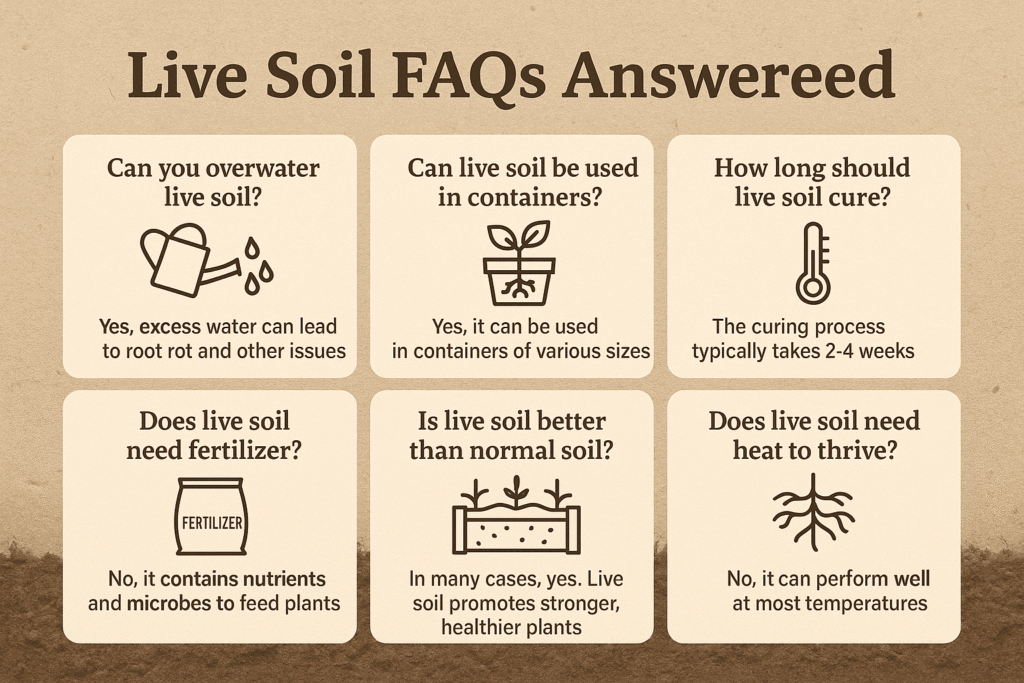
Yes—but live soil is typically more forgiving than sterile soil. Thanks to its high organic matter content and porous structure (like perlite or pumice), it retains moisture well without becoming waterlogged, especially if you’re using breathable pots.
Absolutely. Live soil performs well indoors when paired with proper drainage, lighting, and ventilation. Many indoor cannabis growers prefer it for its flavor enhancement, terpene profile, and reduced need for liquid nutrients.
If you’re building your own living soil, it typically needs 2–4 weeks to “cook” or cure. This allows microbial colonies to stabilize, begin breaking down nutrients, and establish a robust soil food web.
Yes, live soil works well in both. Use fabric pots, air pots, or raised beds to maximize airflow and microbial activity. Ensure the containers allow for proper drainage to prevent anaerobic conditions.
Not necessarily. If your soil is well-prepared with compost, worm castings, and dry amendments, you can often go water-only through the full grow cycle. However, top-dressing or compost teas may be used to boost nutrition mid-cycle.
While cannabis growers often spotlight it, live soil is fantastic for vegetables (tomatoes, peppers, greens), culinary herbs (basil, rosemary), and even flowering ornamentals. Any plant that benefits from biologically rich soil will thrive.
🧠 Pro Tip:
Always monitor your soil for compaction and moisture, and give microbes what they love—oxygen, organic matter, and time. Think of it as feeding the soil, not just the plant.
Final Thoughts – Is Live Soil Right for Your Garden?
If you’re seeking a more natural, low-maintenance, and sustainable way to grow, then switching to live soil may be one of the smartest decisions you can make. Whether you’re cultivating cannabis, vegetables, or herbs, the benefits of biologically active soil extend far beyond simple nutrient delivery.
Live soil isn’t just about growing plants—it’s about building a living ecosystem that works in harmony with nature. By mimicking the biological complexity of forest floors and wild landscapes, living soil creates an environment where roots thrive, microbes flourish, and plants perform at their best without synthetic intervention.
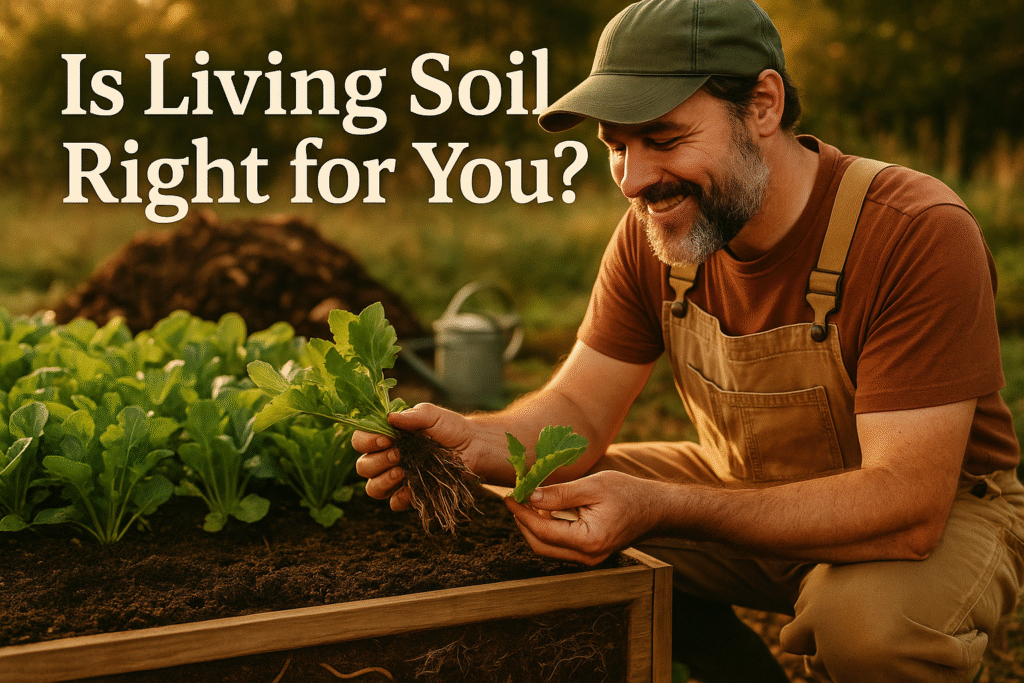
When to Choose Live Soil:
- You want a chemical-free grow system aligned with organic gardening principles
- You’re interested in terpene-rich cannabis, flavorful vegetables, or nutrient-dense herbs
- You prefer a reusable, regenerative soil that improves with each cycle
- You value microbial biodiversity, no-till methods, and natural pest resistance
- You’d rather feed the soil than constantly dose synthetic fertilizers
When It Might Not Be Ideal:
- You need rapid, short-term results (e.g., hydroponic speed)
- You’re not ready to manage microbial balance or amend soil between cycles
- Your environment limits airflow, drainage, or space for soil curing
That said, even if you’re a beginner, there are excellent pre-made living soil brands that make it easy to get started without needing advanced knowledge.
🌱 Final Verdict:
Live soil is a long-term investment in both your plants and the planet. By creating a self-sustaining soil food web, you reduce inputs, improve yields, and participate in a gardening method that respects the balance of nature.
If you’re serious about organic cultivation, improving plant quality, and building a grow system that gets better with every harvest, then live soil isn’t just the right choice—it’s the future of gardening.




